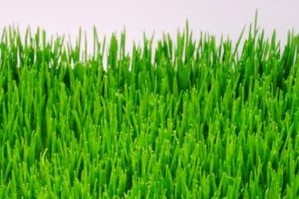Get infused with super green foods.
Wheatgrass is one of those foods that bring up images of hippies in the kitchen getting down and juicy with health foods. Well, speaking from my own personal experience, that’s exactly how I remember having my first wheatgrass elixir- with my groovy hippie friends. Like a rite of passage, it all happened so quickly. The dark green juice was passed to me and I tossed it back not knowing what taste to expect. Wow. It was potent and gave me quite an immediate green rush.
That experience, however, did not demystify this grass that still evokes a curiosity in me today. In fact, just recently, the ubiquitous wheatgrass entered into our lives when we came into possession of many, many live trays of it. Not knowing anything about growing wheatgrass, like whether we should juice it right away or do we plant it outside I figured I better do some research.
I needed to know if taking it in was committing to a big responsibility like if it means we now need to become –uhhm, wheatgrass juicers? I decided, that either way, I knew this super food would be great to explore more of. I have loved it in my favorite super green powder and appreciated it’s health positives so I was excited to learn more about how to grow it and juice it at home.
Health Benefits-
Most notably, wheatgrass is considered a GREEN super-food as it is high in chlorophyll and loaded with anti-oxidant properties. Wheatgrass also contains many essential vitamins and minerals including biotin, b-12, folic acid, vitamin C, vitamin E, iron, calcium and potassium.
More benefits include:
digestive aid
detoxifier
anti inflammatory
strengthens liver function
enhance immune system
cancer prevention
modulate blood pressure and cholesterol
anti-bacterial
reduces body odor
Wheatgrass juice is best taken fresh as a preventative health tonic daily. Drink 1ounce wheatgrass juice on an empty stomach before your meal. If you don’t have access to juicing you can take in the form of a powder or mixed with water or in tablet form.
How to Grow-
Wheatgrass for juicing is typically grown for ease and convenience in trays. I thought at first when we received the live grass we should plant it in the garden but now I realize that it is grown more like growing spouts, meaning it has a very short term growing time rather than a vegetable crop, that has a longer growing season.
- Measure 2 cups winter wheat berries and divide into 2 one-quart sprouting jars. Cover jar with a sprouting lid or cover with cheesecloth. You can also use a sprouting bag. Fill jar or bag with water, swirl around, and soak the wheat berries for no more than 12 hours. Beware that extending the time might promote molding and fermentation.
- Prepare a 20” x 20” tray lined with non-bleached paper with one inch of organic pre-moistened potting soil and set aside.
- After the seeds have soaked for 8 and 12 hours, rinse very well with water until clear and place jar with seeds in a dark spot to begin sprouting.
- After sprouting occurs (10 hours) sprinkle seeds in a single layer over soil in prepared trays.
- Water in generously and keep out of direct sunlight, indoors or outside. Best with temperatures between 60-75 degrees and adequate air circulation.
- Continue to water once daily, keeping soil bed moist.
- Sprouts measuring 9”inches high should be ready in just nine days.
How to Harvest-
Cut one inch from the base of the grass with a serrated knife or scissor. Juice freshly cut wheatgrass immediately or store in a cotton Blue Lotus Produce Bag or in a sealed dish in the refrigerator for up to two weeks. Most likely you will need to discard the cut grass mat and toss into your compost pile as secondary growth isn’t as nutrient dense as first. Or you can experiment and let the grass go to seed. But for most juicing purposes, keeping a fresh supply on hand is best.
*There is a fine balance needed to avoid drying out the seeds on the one hand, and creating moldy conditions on the other so as is with most things in life that you want to both keep the seeds moist and well watered so the can germinate and not die but also not water too much so as to avoid creating a mold growing scenario. And as I am a novice at this, I hear mold does occur and not to worry. If this happens just harvest the grass above the mold areas.
How to juice-
Because humans are unable to digest the cellulose of the wheatgrass, juicing is necessary. And yes, not just any juicer will do. It is required to purchase a wheatgrass juicer for these specific needs. Follow links for more info on juicers…. Prices rages from under $100.00 to thousands of dollars. Experienced and frequent juicers stress the important on spending the money on a better machines especially if you want to use them year after year.
A good quality reliable juicer is the Omega 8005 Nutrition Center. $200 plus, or try a pricier CHROME OSCAR VITALMAX 900, $439.00
The wheatberries themselves are cost friendly at 2.25 for a 1lb. bag
Let us know what your experiences with juicing wheatgrass are!!!

